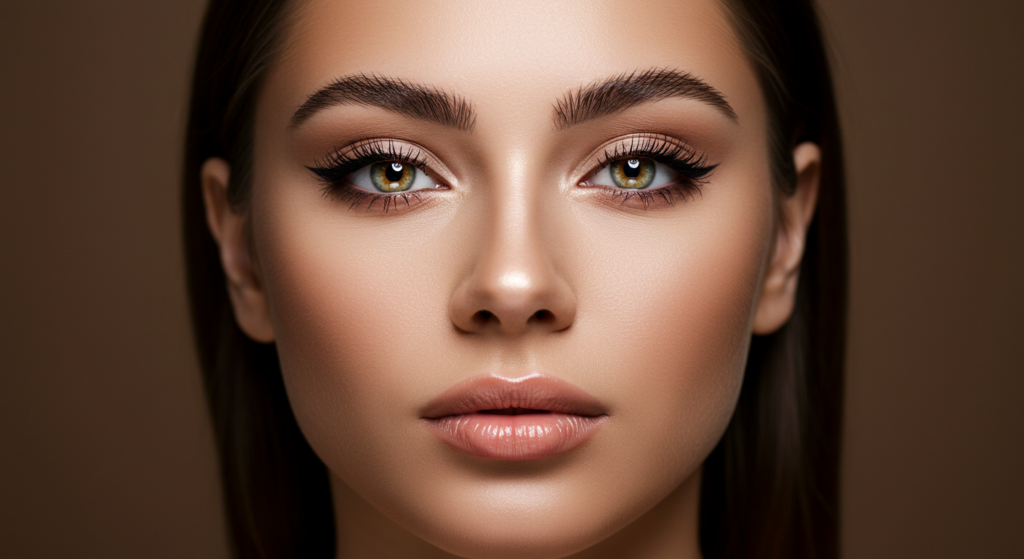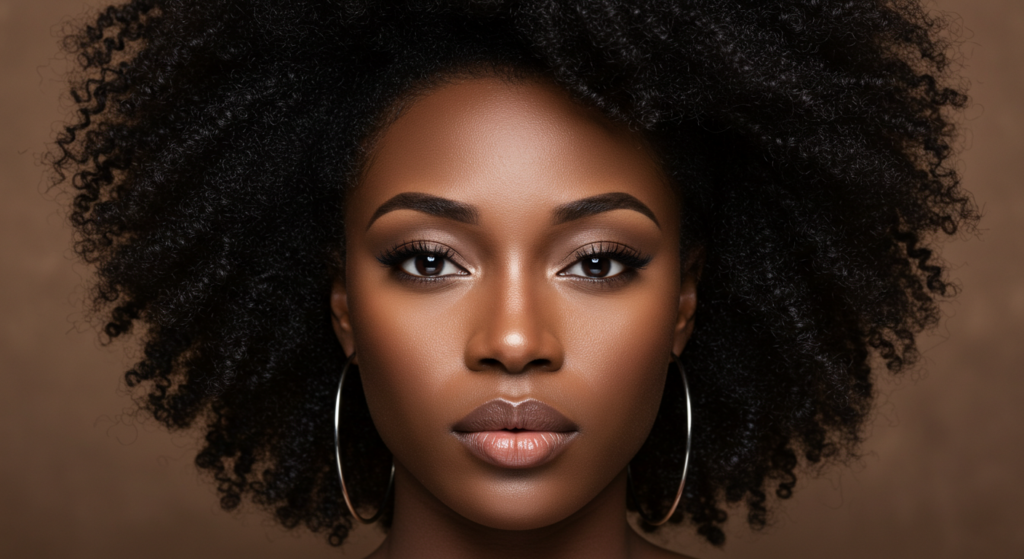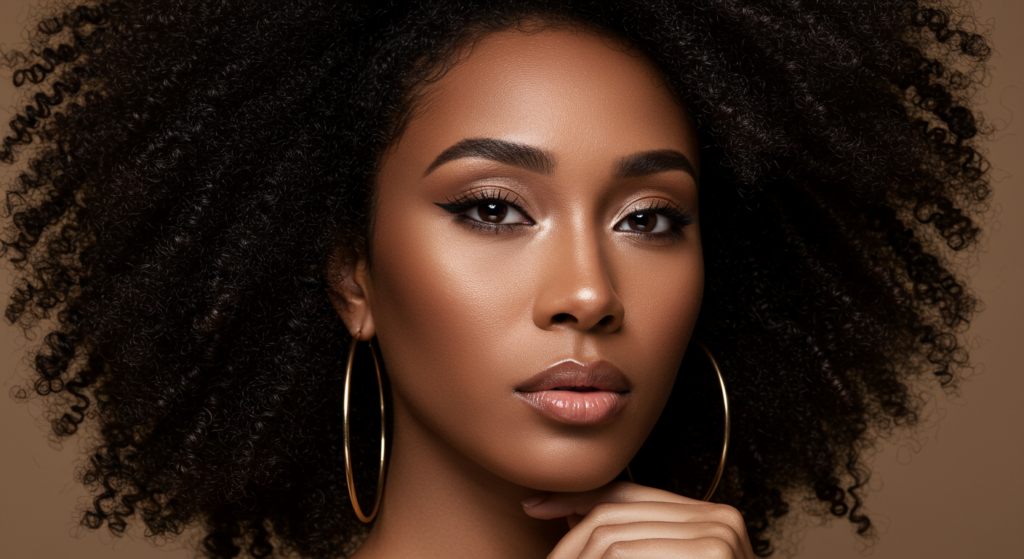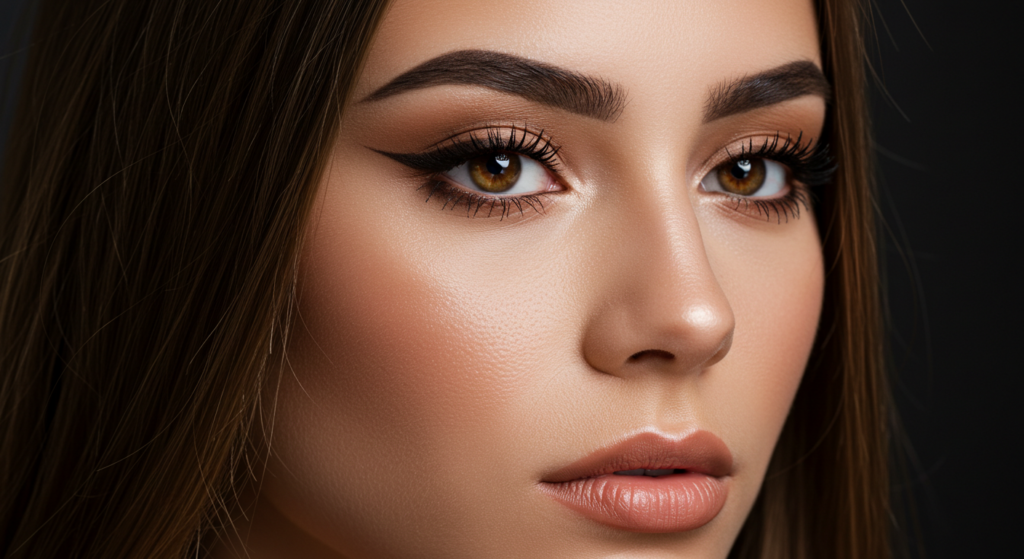As a facial plastic and reconstructive surgeon, I spend a significant amount of time analyzing the intricate details of the human face. Each feature, from the curve of the nose to the fullness of the lips, contributes to the overall harmony and aesthetic appeal we perceive as beauty. Among these features, the eyes hold a particular fascination. They are often described as the windows to the soul, and their shape and orientation play a crucial role in conveying emotions and attracting attention.
One specific characteristic of the eyes that has garnered increasing interest in both the medical and aesthetic realms is the upward canthal tilt. This refers to the upward slant of the line connecting the inner corner (medial canthus) and the outer corner (lateral canthus) of the eye. While seemingly a subtle detail, the upward canthal tilt can significantly impact the overall perception of attractiveness, youthfulness, and even vitality.
In this comprehensive blog post, we will delve deep into the fascinating world of upward canthal tilt. We will explore its anatomical basis, discuss its prevalence across different populations, examine its historical and cultural significance in the context of beauty, and analyze the reasons why it is often associated with an appealing and captivating look. Furthermore, we will touch upon the surgical and non-surgical approaches available to those who desire to enhance or create this specific eye shape.
This is not intended to be a guide for self-diagnosis or treatment. The information provided here is for educational purposes only and should not replace a consultation with a qualified medical professional. If you are considering any cosmetic procedures, it is crucial to seek personalized advice from an experienced surgeon who can assess your individual anatomy and discuss the potential risks and benefits involved.

Table of Contents
The Anatomy of the Eyelid and Canthus: Laying the Foundation
To truly understand the significance of the upward canthal tilt, it’s essential to have a basic grasp of the underlying anatomy of the eyelids and the canthal regions. The term “canthus” refers to the angle where the upper and lower eyelids meet. We have two canthi:
- Medial Canthus: This is the inner corner of the eye, located closer to the nose.
- Lateral Canthus: This is the outer corner of the eye, situated further away from the nose, towards the temples.
The position of these two points relative to each other determines the canthal tilt. When the lateral canthus sits slightly higher than the medial canthus, we perceive an upward canthal tilt. Conversely, if the lateral canthus is lower, it’s referred to as a downward canthal tilt. If they are at roughly the same level, the tilt is considered neutral or horizontal.
The shape and position of the eyelids themselves are influenced by a complex interplay of muscles, tendons, and ligaments. Key structures involved include:
- Orbicularis Oculi Muscle: This circular muscle surrounds the eye and is responsible for closing the eyelids. Its tone and position play a role in the overall shape of the eye area.
- Tarsal Plates: These are dense connective tissue structures within the eyelids that provide support and maintain their shape.
- Canthal Tendons: These are fibrous bands that attach the tarsal plates to the bones of the orbit (eye socket). The medial canthal tendon connects to the nasal bone, while the lateral canthal tendon attaches to the zygomatic bone. The integrity and tension of these tendons are crucial in determining the position of the canthi.
- Suspensory Ligaments: These ligaments, such as Whitnall’s ligament and Lockwood’s ligament, provide further support to the eyelids and the globe of the eye.
The subtle differences in the length, elasticity, and attachments of these structures contribute to the wide variation in eye shapes and canthal tilts we observe among individuals.
Defining Upward Canthal Tilt: The Angle of Beauty
While the concept of an upward canthal tilt is intuitively understood, it can also be defined more objectively by measuring the angle formed by a horizontal line passing through the medial canthus and a line connecting the medial and lateral canthi.
There isn’t a universally agreed-upon “ideal” angle for an upward canthal tilt, as perceptions of beauty are subjective and influenced by cultural factors. However, studies and aesthetic observations suggest that a slight upward tilt, typically ranging from 2 to 10 degrees, is often considered aesthetically pleasing.
It’s important to note that the perceived canthal tilt can also be influenced by other factors, such as the presence of upper eyelid hooding, the prominence of the cheekbones, and the overall shape of the face. For instance, even with a relatively neutral canthal tilt, well-defined cheekbones can create the illusion of an upward slant due to the way they lift and support the lower eyelid.

Prevalence and Cultural Variations: A Global Perspective
The occurrence and prevalence of upward canthal tilt vary across different ethnic groups and populations. It is often observed as a natural characteristic in individuals of East Asian descent, particularly in certain subgroups. In these cultures, the upward slanting eyes are often associated with beauty and are sometimes even referred to poetically.
However, upward canthal tilt is not exclusive to any single ethnicity. It can be found in individuals of various backgrounds, although the degree of the tilt may differ. Genetic factors play a significant role in determining an individual’s natural canthal tilt.
Interestingly, the perception and desirability of an upward canthal tilt can also vary across cultures and time periods. What is considered beautiful in one culture or era may not be in another. However, the association of an upward canthal tilt with youthfulness and vitality seems to be a relatively consistent theme across different societies.
Historical Perspectives on Beauty and the Eyes: A Journey Through Time
Throughout history, the eyes have been a central focus in artistic representations and discussions of beauty. Ancient civilizations often depicted idealized figures with specific eye shapes that were considered attractive.
In ancient Egypt, for example, elongated eyes with a defined shape were highly prized, as evidenced by the iconic depictions in their art and hieroglyphs. The application of kohl eyeliner further accentuated the shape and could have created the illusion of a more pronounced canthal tilt.
In classical Greek and Roman art, idealized beauty often featured symmetrical facial features and well-proportioned eyes. While the emphasis may not have been solely on the upward tilt, the overall harmony of the eye area was considered crucial.
During the Renaissance, artists continued to explore the nuances of facial beauty, and the eyes remained a focal point. Paintings from this era often depict figures with expressive eyes that contribute significantly to their overall allure.
In more recent times, the rise of photography and cinema has further shaped our perceptions of beauty, and the upward canthal tilt has often been highlighted as a desirable feature, particularly in models and actresses who are considered to possess captivating eyes.
The Upward Canthal Tilt as a Feature of Attractiveness: Unpacking the Appeal
Why is an upward canthal tilt so often associated with attractiveness? Several factors may contribute to this perception:
- Youthfulness: As we age, the tissues around the eyes tend to lose elasticity, and the lateral canthus can droop slightly, leading to a more neutral or even downward canthal tilt. Therefore, an upward tilt can be subconsciously associated with youth and vitality.
- Alertness and Energy: The upward slant of the eyes can convey a sense of alertness, energy, and enthusiasm. This can make an individual appear more engaging and approachable.
- Femininity: In many cultures, an upward canthal tilt is often considered a feminine trait, contributing to a softer and more alluring appearance.
- Exoticism and Uniqueness: Depending on an individual’s overall features and ethnic background, an upward canthal tilt can add a touch of exoticism and make their appearance more distinctive and memorable.
- Emotional Expression: The shape and tilt of the eyes play a crucial role in conveying emotions. An upward tilt can contribute to a look that is perceived as happy, playful, or even slightly mischievous.
From an evolutionary perspective, certain facial features, including those around the eyes, may have signaled health, fertility, and genetic fitness to potential mates. While the specific role of canthal tilt in this context is not fully understood, it’s possible that the association with youthfulness and vitality played a part in its perceived attractiveness.
Factors Influencing Canthal Tilt: Nature and Nurture
An individual’s canthal tilt is primarily determined by their genetics. The inherited variations in the shape of the skull, the position of the orbital bones, and the attachments of the canthal tendons all contribute to the natural slant of the eyes.
While genetics is the primary factor, certain conditions and lifestyle choices can also influence the perceived or actual canthal tilt over time:
- Aging: As mentioned earlier, the natural aging process can lead to a weakening of the supporting tissues around the eyes, causing the lateral canthus to droop.
- Gravity: The constant pull of gravity can also contribute to the downward migration of the soft tissues around the eyes.
- Sun Exposure: Chronic sun exposure can damage the collagen and elastin in the skin, leading to laxity and potentially affecting the position of the eyelids and canthi.
- Certain Medical Conditions: Some medical conditions, such as thyroid eye disease or facial nerve palsy, can affect the position and movement of the eyelids and may impact the canthal tilt.
- Trauma: Injury to the eye area can also alter the position of the canthi.
It’s important to differentiate between the natural, genetically determined canthal tilt and any changes that may occur due to these external factors.

Surgical and Non-Surgical Approaches to Modifying Canthal Tilt: Options for Enhancement
For individuals who desire to alter their canthal tilt for cosmetic reasons, both surgical and non-surgical options are available. The most appropriate approach will depend on the individual’s specific anatomy, the desired outcome, and their tolerance for downtime and potential risks.
Surgical Options: The Precision of Canthoplasty and Canthopexy
The two primary surgical procedures that directly address the canthal tilt are canthoplasty and canthopexy. While the names sound similar, they involve slightly different techniques and achieve different outcomes.
Canthoplasty: Reshaping the Outer Corner
Canthoplasty is a more invasive surgical procedure that involves repositioning the lateral canthal tendon. This allows the surgeon to actually change the shape and angle of the outer corner of the eye.
The procedure typically involves the following steps:
- Anesthesia: The surgery is usually performed under local anesthesia with sedation or general anesthesia, depending on the extent of the procedure and the patient’s preference.
- Incision: A small incision is made in the natural crease of the upper eyelid, extending slightly beyond the lateral canthus.
- Tendon Release: The lateral canthal tendon is carefully identified and released from its attachment to the orbital bone.
- Repositioning and Fixation: The tendon is then repositioned at a higher and more desirable location. It is secured to the periosteum (the outer layer of bone) using sutures.
- Closure: The skin incision is closed with fine sutures.
Canthoplasty can effectively create a more pronounced upward canthal tilt and can also address issues such as a round or hooded outer eye shape. It is often performed in conjunction with other eyelid surgeries, such as blepharoplasty (eyelid lift), to achieve a more comprehensive rejuvenation of the eye area.
Canthopexy: Supporting the Outer Corner
Canthopexy, on the other hand, is a less invasive procedure that focuses on tightening and supporting the lateral canthal tendon without actually detaching and repositioning it.
The typical steps involved in canthopexy are:
- Anesthesia: Similar to canthoplasty, local anesthesia with sedation or general anesthesia may be used.
- Incision: A small incision is made near the lateral canthus.
- Tendon Tightening: The lateral canthal tendon is identified and tightened by placing sutures that anchor it to the periosteum at a slightly higher position.
- Closure: The skin incision is closed with sutures.
Canthopexy is often used to address mild lateral canthal drooping or to provide additional support to the lower eyelid during lower blepharoplasty. While it can create a subtle lift in the outer corner of the eye, the change in the canthal tilt is typically less dramatic compared to canthoplasty.
Non-Surgical Options: Creating the Illusion of Lift
While surgery is the only way to permanently alter the canthal tilt, non-surgical treatments can be used to create the illusion of an upward slant or to address factors that may be contributing to a downward tilt.
- Botulinum Toxin (Botox): Strategic injections of Botox around the outer corner of the eye can help to relax the muscles that pull the lateral canthus downwards. This can result in a subtle lift and the appearance of a more upward tilt.
- Dermal Fillers: Injectable fillers can be used to add volume to the upper cheek area, providing support to the lower eyelid and potentially lifting the outer corner of the eye. Fillers can also be used to subtly augment the area around the lateral canthus to create a more defined and lifted appearance.
- Thread Lifts: Absorbable threads with small barbs can be inserted under the skin to lift and tighten the tissues around the eyes, including the outer corners. While the results are temporary, thread lifts can provide a noticeable improvement in the canthal tilt for some individuals.
- Makeup Techniques: Skilled use of makeup, such as eyeliner and eyeshadow, can create a visual illusion of an upward canthal tilt. By extending the eyeliner slightly upwards at the outer corner and using strategic shading, the eyes can appear more slanted.
It’s important to have realistic expectations regarding the results of non-surgical treatments, as they are temporary and the degree of change may be limited compared to surgical options.

Considerations Before Seeking Treatment: Making Informed Decisions
If you are considering any surgical or non-surgical procedures to modify your canthal tilt, it is crucial to approach the decision-making process with careful consideration and realistic expectations.
Here are some important factors to keep in mind:
- Consultation with a Qualified Surgeon: Seek a consultation with a board-certified facial plastic surgeon or oculoplastic surgeon who has extensive experience in performing canthoplasty and canthopexy. Discuss your goals, expectations, and any underlying medical conditions you may have.
- Realistic Expectations: Understand that while surgery can enhance the upward canthal tilt, it may not be possible to achieve the exact look you desire. Your surgeon will assess your individual anatomy and explain what is realistically achievable.
- Potential Risks and Complications: All surgical procedures carry some risks, including infection, bleeding, scarring, asymmetry, and changes in sensation. Be sure to discuss these potential complications with your surgeon and understand the measures that will be taken to minimize them.
- Downtime and Recovery: Surgical procedures will require some downtime for healing. Be prepared for potential swelling, bruising, and discomfort in the initial recovery period. Follow your surgeon’s post-operative instructions carefully to ensure proper healing.
- Cost: The cost of surgical and non-surgical procedures can vary depending on the extent of the treatment and the surgeon’s fees. Discuss the costs involved upfront and ensure you have a clear understanding of the financial commitment.
- Non-Surgical Limitations: Remember that non-surgical treatments are temporary and will require periodic maintenance to sustain the results.
Ultimately, the decision to undergo any cosmetic procedure is a personal one. It’s essential to be well-informed, have realistic expectations, and choose a qualified and experienced practitioner to ensure the best possible outcome.
The Role of Upward Canthal Tilt in Facial Harmony: A Holistic Perspective
While the upward canthal tilt can be an attractive feature on its own, its impact is also influenced by its relationship with other facial features. Facial harmony is achieved when all the different elements of the face are in balance and proportion.
An upward canthal tilt can complement other features such as high cheekbones, a defined jawline, and a well-proportioned nose. The overall effect can be a more youthful, vibrant, and aesthetically pleasing appearance.
However, it’s important to consider the face as a whole. An overly pronounced upward canthal tilt may not be in harmony with other features and could potentially look unnatural. The goal of any cosmetic procedure should be to enhance the natural beauty of the individual while maintaining facial balance and proportion.
A skilled surgeon will take into account the patient’s entire facial structure when planning any procedure to modify the canthal tilt. They will assess the relationship between the eyes and other features to ensure a natural and harmonious result.
Debunking Misconceptions: Separating Fact from Fiction
There are several misconceptions surrounding upward canthal tilt and the procedures used to modify it. Let’s address some of the common ones:
- Myth: Upward canthal tilt is only desirable in women.
- Fact: While often associated with femininity, an upward canthal tilt can also be an attractive feature in men, contributing to a more alert and youthful appearance.
- Myth: Canthoplasty and canthopexy are purely cosmetic procedures.
- Fact: While often performed for cosmetic reasons, these procedures can also be used to address functional issues such as lower eyelid laxity or retraction, which can cause dry eyes and discomfort.
- Myth: Non-surgical treatments can achieve the same results as surgery for canthal tilt.
- Fact: Non-surgical treatments can create the illusion of a lift or address mild drooping, but they cannot permanently alter the underlying anatomical structure of the canthal tilt in the same way that surgery can.
- Myth: Any surgeon can perform canthoplasty or canthopexy effectively.
- Fact: These are delicate surgical procedures that require specialized knowledge and experience in facial anatomy and surgical techniques. It’s crucial to choose a board-certified surgeon with specific expertise in this area.
- Myth: Upward canthal tilt is a sign of a particular personality trait.
- Fact: The shape and tilt of the eyes are primarily determined by genetics and do not indicate any specific personality traits.
By understanding the facts and separating them from common misconceptions, individuals can make more informed decisions about whether or not to pursue any treatments to modify their canthal tilt.
Conclusion: Embracing Individual Beauty and Informed Choices
The upward canthal tilt is a fascinating facial feature that has been associated with beauty and attractiveness across various cultures and throughout history. While a slight upward slant of the eyes is often considered aesthetically pleasing, it’s important to remember that beauty is subjective and what one person finds attractive, another may not.
The decision to pursue surgical or non-surgical treatments to modify the canthal tilt is a personal one that should be made after careful consideration, thorough research, and consultation with a qualified medical professional. It’s crucial to have realistic expectations, understand the potential risks and benefits involved, and prioritize your overall facial harmony and well-being.
As a surgeon, my goal is to help my patients enhance their natural beauty and achieve their aesthetic goals in a safe and effective manner. Whether you are considering a subtle non-surgical enhancement or a more significant surgical correction, the key is to make informed choices and work with an experienced practitioner who understands your individual needs and desires.
Ultimately, the most important aspect of beauty is confidence and self-acceptance. While cosmetic procedures can help to enhance certain features, true beauty radiates from within. Embrace your unique features and celebrate your individuality.
Thank you for taking the time to learn more about the characteristics and perceptions of beauty related to the upward canthal tilt. If you have any further questions or would like to schedule a consultation, please do not hesitate to contact my office.
Visit Dr.MFO Instagram profile to see real patient transformations! Get a glimpse of the incredible results achieved through facial feminization surgery and other procedures. The profile showcases before-and-after photos that highlight Dr. MFO’s expertise and artistic vision in creating natural-looking, beautiful outcomes.
Ready to take the next step in your journey? Schedule a free consultation with Dr. MFO ( Best Facial Feminization Surgeon for You) today. During the consultation, you can discuss your goals, ask any questions you may have, and learn more about how Dr. MFO can help you achieve your desired look. Don’t hesitate to take advantage of this free opportunity to explore your options and see if Dr. MFO is the right fit for you.









